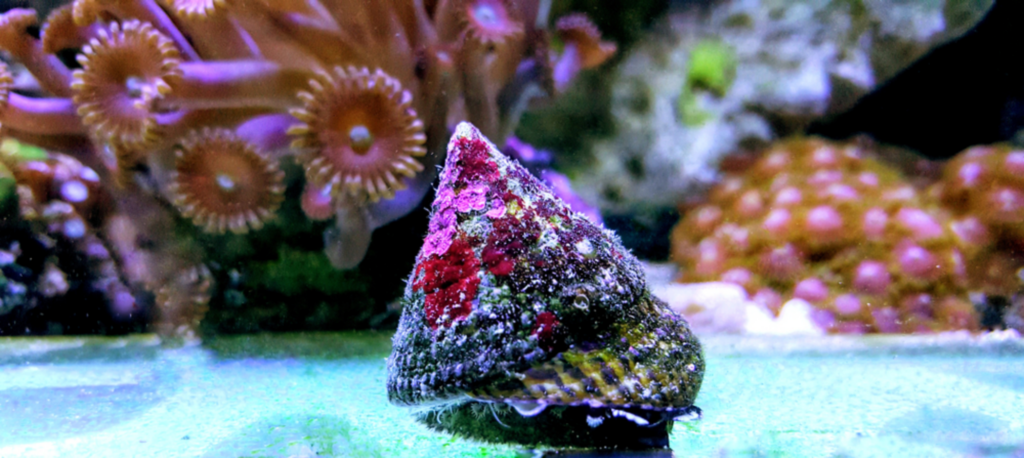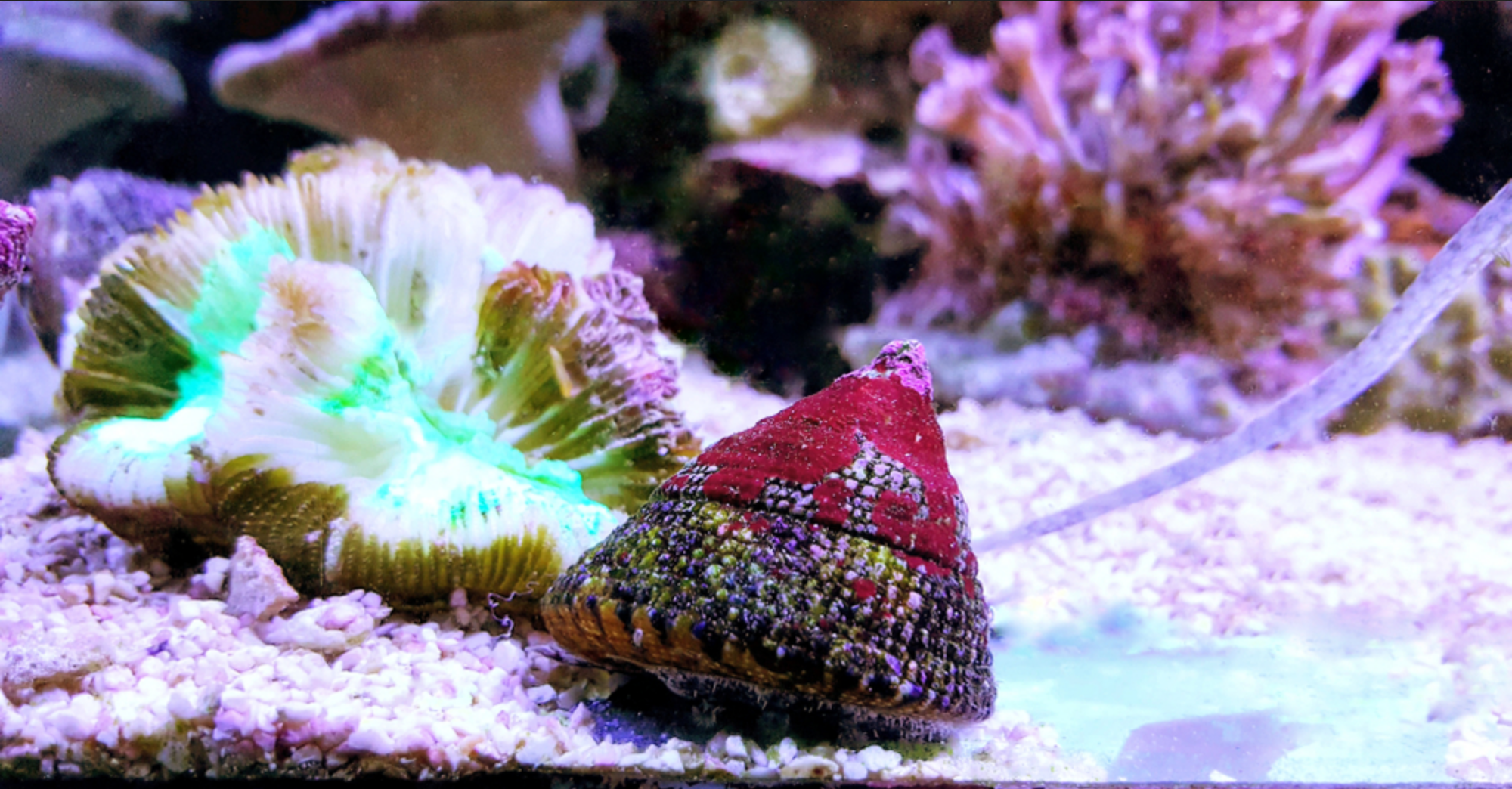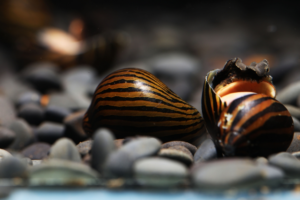Imagine an underwater world teeming with vibrant corals, dancing fish, and a captivating array of marine life. In this aquatic wonderland, one species stands out with its striking appearance and remarkable abilities. Meet the Trochus snail, a fascinating creature that has captured the hearts of aquarists worldwide.
Trochus snails are herbivorous that graze on tank algae and detritus, making them an ideal addition to a minimum 10-gallon (38-liter) tank with water conditions of 74-79°F (23-26°C) and a pH of 8.1 – 8.4, and medium to dim lighting. Trochus snails coexist well with non-aggressive tank mates.
This guide provides valuable insights for enthusiasts interested in raising Trochus snails. Here, you will delve into their feeding habits, breeding process, behavior, common issues, and essential considerations for setting up their tank.
Origin and Habitat

Originating from the western Pacific and Southeast Asia, Trochus snails (Trochus sp.) belong to the family Trochidae, which encompasses marine snails with top-shaped shells.
While the earliest documented sightings of these snails were in Indonesia and Nicaragua, they have gradually spread to various parts of the world. Today, they are commonly encountered in tropical marine waters, particularly in the following areas:
- Indian Ocean
- Indo-Pacific
- Southeastern Atlantic
In their natural habitat, Trochus snails reside in shallow waters near coral reefs, where algae and cyanobacteria thrive. They prefer depths of less than 66 ft (20 meters), making rocky shore areas a common location for their presence.
Appearance and Size
| Trochus Snail Characteristics | Description |
| Shell Characteristics | Thick, conical-shaped with a flat base |
| 5-10 whorls | |
| Colors: creamy white, purplish, greenish with brown patches | |
| Shell Branding (Lines) | Numerous narrow, horizontally inclined radiating lines |
| Tentacles | Present around the body for sensory purposes |
| Operculum | Circular trapdoor with visible concentric rings |
| Size (In Captivity) | Shell Diameter: 2 inches (5 cm) |
| Body Length: 2.5 inches (6 cm) | |
| Size (In the Wild) | Shell Diameter: Up to 3 inches (8 cm) |
| Body Length: Up to 4 inches (10 cm) | |
| Ideal Habitat Conditions | Shallow waters near coral reefs (<20 meters) |
| Access to algae and cyanobacteria |
The genus Trochus comprises over 30 species that bear a striking resemblance to one another, with only minor variations in color serving as distinguishing features. This remarkable similarity often poses a challenge for aquarists trying to accurately identify the specific species they have.
Nevertheless, among the vast array of options, five species have emerged as the most commonly found in pet stores:
- Trochus noduliferus
- Trochus histrio
- Trochus radiates
- Trochus maculatus
- Trochus niloticus
Your Trochus snail likely belongs to one of these species.
These snails typically possess a thick, conical-shaped shell with a flat base and approximately 5-10 whorls. While their shells come in various colors, the following are the most commonly observed colors:
- Creamy white
- Purplish
- Greenish shades with brownish patches
A distinctive characteristic of Trochus snails is the presence of numerous narrow, horizontally inclined radiating lines on their shells, which earned them the moniker “banded trochus snails.”
Another notable feature is the series of tentacles encircling their bodies, which serve as sensory organs and aid in detecting organic food substances in their surroundings.
Trochus snails possess an operculum—a circular, distinctly marked trapdoor—that they utilize as a protective measure. When faced with a threatening situation, they retreat deep into the coils of their shells and shield themselves by closing the trapdoor.
In a captive environment, Trochus snails typically reach an average shell diameter of 2 inches (5 cm) and a body length of 2.5 inches (6 cm). However, in the wild, these snails can grow slightly larger, with scientists documenting shell diameters of up to 3 inches (8 cm) and body lengths of 4 inches (10 cm).
This difference in size can be attributed to optimal water parameters, proper feeding, and reduced stress levels found in their natural habitat. In their native habitat, Trochus snails thrive in ideal water conditions and have access to a suitable diet.
Trochus Snail Lifespan
Trochus snails typically have a lifespan of 2-3 years in captivity. However, with proper care, they can live up to 4 years under controlled conditions.
In the wild, where ideal conditions prevail, certain species of Trochus snails, like the Trochus niloticus, have been documented to live an impressive lifespan of up to 7 years.
Buying Trochus Snail

Trochus snails are commonly available in most pet stores, but selecting healthy specimens can be challenging, especially for beginners. Pet stores are primarily driven by commercial interests, and proprietors may not always inform you of potential health issues with the snails.
However, you can easily identify a healthy snail through observation. Take note of the following:
- Consider their activity levels. Healthy snails are active creatures that actively scour the tank for food and should be firmly attached to tank surfaces. Avoid snails that appear inactive or are floating upside down in the tank.
- Inspect the condition of their shells. A healthy shell will be intact, without cracks or pits. Steer clear of snails with cracked, pitted, or discolored shells, which may indicate inadequate calcium or exposure to toxic tank conditions.
- Opt for smaller-sized Trochus snails, ranging between 1-2 inches (2.5-5 cm) in length. Snail size corresponds with age, and smaller snails are generally younger. Younger snails have higher energy levels and are less prone to illness compared to older snails.
Unhealthy Trochus snails may quickly perish after introduction to your reef tank due to their lethargic state and difficulty adapting to the acclimatization process. Additionally, such snails are less likely to reproduce due to low energy levels and stress.
Trochus Snails Care

Tank Size and Set Up
Trochus snails are delicate creatures that thrive in a stable environment and are sensitive to rapid changes in water parameters. To provide them with an optimal habitat, it is recommended to keep them in larger tanks.
Recommended Reading: How Many Snails Per Gallon?
For a small group of up to 5 Trochus snails, a minimum tank size of 10 gallons (38 liters) is recommended. Alternatively, a single Trochus snail can be housed in a smaller 2-gallon tank (8-liter).
Larger tanks offer several advantages, such as maintaining stable water parameters for longer periods due to their larger surface area and volume. These larger volumes of water retain temperature, hold more oxygen, and better maintain chemical balance.
For beginners, I recommend the Aqueon Standard Glass 10-Gallon Rectangular Tank from Amazon. This tank is sturdy, transparent, and can comfortably accommodate up to 5 Trochus snails.
| Preview | Product | |
|---|---|---|

|
Aqueon Standard Glass 10 Gallon Rectangular Tank for Aquariums & Terrariums | Check Price |
If you plan to create a community tank where snails coexist with other creatures, the larger Oceanic Systems All Glass Aquarium AAG10021 20-gallon tank is suitable. You simply need to set up your filtration and lighting systems, and you are good to go.
| Preview | Product | |
|---|---|---|

|
All Glass Aquarium AAG10021 Tank, 20l | Check Price |
Ideal Water Parameters
| Ideal Water Parameters | Range |
| Temperature | 74-79°F (23-26 °C) |
| pH | 8.1 – 8.4 |
| Hardness | 8 – 12 |
| Lighting | Medium to bright community tank lighting |
However, it’s important to note that Trochus snails are nocturnal creatures; therefore, lighting is not specifically necessary for them. In community reef tank settings, it is crucial to consider the lighting needs of other tank inhabitants, especially corals, as they are photosynthetic organisms.
In addition to lighting, monitoring the levels of calcium and magnesium in a marine tank is essential for proper shell growth and optimal snail development.
Calcium levels should be maintained between 400 to 450 Parts Per Million (PPM), while magnesium levels should be maintained between 1250 and 1350. Exceeding these levels has resulted in lethargy in Trochus snails and, in extreme cases, even caused death.
To ensure accurate monitoring of marine tank parameters, I recommend the Triton Labs ICP-OES Saltwater Reef Testing Kit from Amazon. This comprehensive kit tests for 32 elements, including calcium and magnesium, allowing you to maintain the optimal environment for coral growth and development.
| Preview | Product | |
|---|---|---|

|
Triton Labs ICP-OES Water Test- Full Panel of 32 Elements – Saltwater Reef Testing Kit | Check Price |
Substratum
Reef tanks, which house fish, invertebrates, and corals, require the introduction of live rocks and coral into the tank. These rocks support coral growth crucial for maintaining a balanced reef tank ecosystem.
Trochus snails are not burrowers, so you may not need any additional substrate. Trochus snails will happily crawl, hide, and explore the crevices and caves formed by these rocks.
Trochus Snails Feeding
Trochus snails are omnivores that primarily graze on corals and rocks. They have a diverse diet, consuming various types of algae, such as:
- Brown algae
- Green algae
- Hair algae
- Filamentous algae
Trochus snails also scavenge corals for diatoms and cyanobacteria.
In reef tank setups where competition for food is present, supplementing the diet of Trochus snails becomes important. Adding occasional fish or shrimp foods to the tank ensures that the nutritional requirements of these snails are adequately met.
Consider providing supplemental foods for your fish, such as:
- Pills
- Flakes
- Bottom feeder pellets
- Algae/Spirulina wafers
I recommend adding supplemental food to the tank every two days and removing any uneaten food after 24 hours. It’s important to prevent decaying leftover food, as it can increase ammonia levels and disrupt the water parameters of your tank.
Additionally, it’s essential to note that Trochus snails produce waste throughout the tank when well-fed. During water changes, it’s crucial to remove this waste to maintain the water parameters of your tank for a longer period.
Breeding Trochus Snails
Trochus snails are heterosexual creatures that rely on cross-fertilization for breeding. Mating is not necessary for reproduction to occur.
The female Trochus snail releases millions of underdeveloped eggs into the tank through spawning. These eggs undergo development in preparation for fertilization.
The male Trochus snail releases sperm into the tank, creating a visible cloud-like substance. The sperm fertilizes the developed eggs, which then develop into larvae and settle on the tank floor.
Within 3-7 days, these larvae grow into tiny new snails. The entire reproduction process typically takes around 3 weeks.
It’s important to note that not all released eggs will develop and get fertilized. Other tank inhabitants may consume some eggs, while others may fail to develop properly due to genetic and environmental factors. On average, only 10-50 larvae successfully develop into adult snails.
Suitable Tank Mates
Trochus snails are generally peaceful species that coexist well with other tank mates. They easily thrive in peaceful tank environments.
Trochus snails are compatible with the following:
| Fish | Shrimp | Snails |
| Clownfish | Sexy Shrimp | Astrea Snails |
| Midas Blenny | Red Fire Shrimp | Cerith Snails |
| Blue-Green Chromis | Peppermint Shrimp | Mexican Turbo Snails |
| Royal Gramma | Bumblebee Shrimp Skunk Cleaner |
However, certain tank mates are unsuitable for trochus snails:
- Rays
- Crabs
- Octopus
- Triton
Hermit crabs are known to kill trochus snails solely to acquire their shells, while the other creatures listed above may prey on these snails for food. Simply adding empty snail shells to the tank does not guarantee the safety of trochus snails within the tank.
Common Problems
Like other marine snails, trochus snails can suffer from several parasitic diseases, including:
- Angiostrongyliasis: an inflammation of the gastrointestinal and CNS system.
- Clonorchiasis: a liver disease caused by flukes.
- Fascioliasis: a liver inflammation caused by worms.
- Shell disorders are also not uncommon in marine snails.
The best approach to dealing with these issues is to quarantine affected snails to prevent the spread of pathogens to healthy tank inhabitants.
Closing Remarks
Marine tank enthusiasts have a wide range of options to choose from, but trochus snails stand out for their ornamental value and exceptional cleaning abilities.
These snails are excellent scavengers and are easy to care for. They coexist peacefully with other non-aggressive marine creatures. With optimal water conditions and a proper diet, trochus snails thrive in aquariums.
Now that you have learned how to care for trochus snails, consider introducing them to your tank. I value feedback and am available to answer any questions to enhance your experience as an aquarist.
Frequently Asked Questions
How many trochus snails per gallon?
The banded trochus snail requires adequate space to thrive. To maintain a healthy environment, it’s generally recommended to keep one snail for every two to three gallons (8-11 liters) of aquarium water. This allows the snail enough room to move around and perform its natural behaviors, such as scavenging for algae.
Can trochus snails right themselves?
Trochus snails can right themselves up most of the time, in approximately 90% of instances when they are overturned. Despite being slightly more expensive, aquarists often choose these snails due to this capability, along with their potential to live for several years.
Do trochus snails eat cyano?
Trochus snails are known to consume cyanobacterial sheets, setting them apart from many other snail species. This makes them particularly valuable in controlling and reducing cyanobacteria in an aquarium environment.
Sources
- NIH: Fasciola hepatica: Infection Status of Freshwater Snails Collected from Gangwon-do (Province), Korea
- NIH: Modeling the Transmission Dynamics of Clonorchiasis in Foshan, China
- Hawaii State Department of Health: Angiostrongyliasis (Rat Lungworm)
- Mindat.org: Trochidae
- Hanna Instruments: Calcium in Freshwater Snail Aquariums



